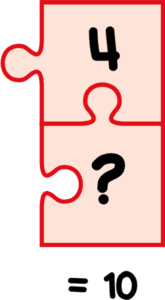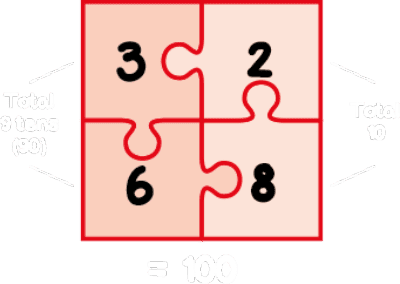Jigsaw Numbers
The simple way to master Number Bonds
Jigsaw Numbers make learning Number Bonds and Number Facts simple!
- A Number Bond is a pair of numbers that always make the same total when added together
- Number Facts are simple calculations with 2 numbers.
Learning number facts is crucial to developing fluency in maths, and mental maths skills. To make this simpler for children, in Big Maths we use the image of a 2 piece jigsaw with a number on each piece, allowing a simple illustration of how Jigsaw Numbers can be put together in a ‘finished picture’, then added together to make a total.

Jigsaw Numbers are special (10, 100, or 1000 for example). Explain the jigsaw analogy and ask children to complete the jigsaw, simple! For example, if 4 is on one jigsaw piece, ask the child if they can tell us what would be on the missing piece if the total is 10.
If we can see the maths it helps us to understand the maths.
Jigsaw Numbers to 10
Ready for the challenge of Jigsaw numbers to 10? This is an oral activity to enjoy, have fun with it! Just ask your child to tell you the number needed to make 10, then refresh the screen to try another number. In the example above, the correct answer is 6! How fast can you go?
Simply refresh your screen to change the number!
The true power of Jigsaw Numbers becomes clear as you use them with larger numbers, simplifying addition and subtraction of 2 numbers to 1 or more 1 digit + 1 digit sums! Suddenly addition and subtraction of numbers to 100, 1000 and beyond become simple, instant mental maths.
We want all children to feel, and embrace the power, confidence and freedom of fluency and mental maths skills. Experience the surprise and joy for yourself with Jigsaw Numbers to 100 below.
Jigsaw Numbers to 100 and Beyond!
Just remember:
- In the ‘ones’ column (or the right hand column) you want the Jigsaw Number to 10
- In every other column, you want the Jigsaw Number to 9
To work out the Jigsaw Number to 100, just do two simple sums! In this example 2+8= 10 and 3+6= 9 so the answer is 68! Amazing! you just worked out 100 – 32 = 68 in seconds!

The target is still to find the missing Jigsaw Numbers quickly. Focus on the 2 simple sums, they always give you the right Jigsaw Number to 100!
Simply refresh your screen (hit the F5 button) to change the numbers!
When you can answer both simple sums quickly, and you want to increase the challenge further, try reframing the questions;
- just ask the subtraction question (100 – 32 = ?) or,
- ask a missing number box questions (32 + ⬜ = 100), or
- placing the questions into the context of money, or other units of measure (£1 – 32p = ?).
Each of these questions uses 32 (from the first example provided above).
Jigsaw Numbers to 1000
Now you just find the Jigsaw Number to 10 in the hundreds column!
It’s that simple! Work out 1,000 minus any 3 digit number in seconds!